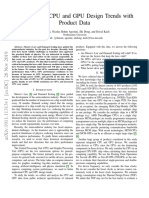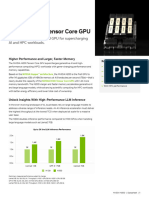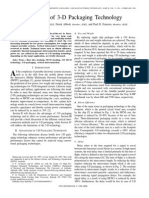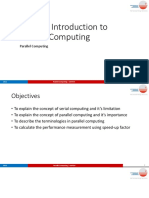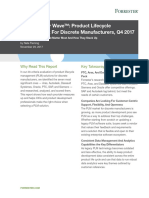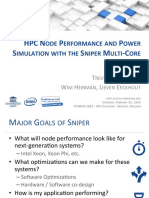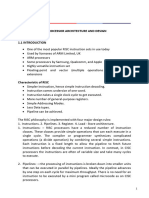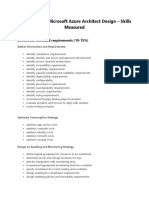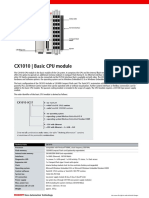Introduction to
High-Performance Computing
�What is High Performance Computing?
• There is no clear definition
– Computing on high performance computers
– Solving problems / doing research using computer modeling, simulation and analysis
– Engineering design using computer modeling, simulation and analysis
• My understanding
– A huge number of computational and memory requirements
– Cannot be afforded by a PC efficiently
– Speeds and feeds are the keywords
• Who uses High-Performance Computing
– Research institutes, universities and government labs
• Weather and climate research, bioscience, energy, military etc.
– Engineering design: more or less every product we use
• Automotive, aerospace, oil and gas explorations, digital media, financial simulation
• Mechanical simulation, package designs, silicon manufacturing etc.
• Similar concepts
– Parallel computing: computing on parallel computers
– Super computing: computing on world 500 fastest supercomputers
2
�When Do We Need High Performance Computing?
• Case1: Complete a time-consuming operation in less time
– I am an automotive engineer
– I need to design a new car that consumes less gasoline
– I’d rather have the design completed in 6 months than in 2 years
– I want to test my design using computer simulations rather than building very expensive prototypes and crashing
them
• Case 2: Complete an operation under a tight deadline
– I work for a weather prediction agency
– I am getting input from weather stations/sensors
– I’d like to predict tomorrow’s forecast today
• Case 3: Perform a high number of operations per seconds
– I am an engineer at Amazon.com
– My Web server gets 1,000 hits per seconds
– I’d like my web server and databases to handle 1,000 transactions per seconds so that customers do not experience
bad delays
3
�What Does High Performance Computing Include?
• High-performance computing is fast computing
– Computations in parallel over lots of compute elements (CPU, GPU)
– Very fast network to connect between the compute elements
• Hardware
– Computer Architecture
• Vector Computers, MPP, SMP, Distributed Systems, Clusters
– Network Connections
• InfiniBand, Ethernet, Proprietary
• Software
– Programming models
• MPI (Message Passing Interface), SHMEM (Shared Memory), PGAS, etc.
– Applications
• Open source, commercial
4
�Rise and Fall of HPC Computer Architectures
• Vector Computers (VC) - proprietary system
– Provided the breakthrough needed for the emergence of computational science, but they were only a partial answer
• Massively Parallel Processors (MPP) - proprietary systems
– High cost and a low performance/price ratio.
• Symmetric Multiprocessors (SMP)
– Suffers from scalability
• Distributed Systems
– Difficult to use and hard to extract parallel performance
• Clusters – commodity and highly popular
– High Performance Computing - Commodity Supercomputing
– High Availability Computing - Mission Critical Applications
5
�Top500 Supercomputers List – System Architecture (June 2017)
Clusters have
become the most
used HPC system
architecture
More than 86% of
Top500 systems
are clusters
6
�Computer Food Chain: Causing the Demise of Specialized Systems
Parallel Computing on a Large Number of Servers is More
Efficient than using Specialized Systems
7
�HPC Clusters – Affordable, Efficient and Scalable HPC Solution
• Since the 1990s, there has been an increasing trend to move away from expensive
/specialized proprietary parallel supercomputers to clusters of computers
– From specialized supercomputers to cost effective, general purpose systems
• So What’s So Different about Clusters?
– Commodity, standard, affordable, cost effective, scalable and reliable architecture
Cluster Architecture
Server Server Server Server
Communications Communications Communications Communications
Software Software Software Software
Network Interface Network Interface Network Interface Network Interface
Hardware Hardware Hardware Hardware
Cluster Interconnect Network
8
�Interconnect Technology: The Need for Speed and Intelligence
400G
Homeland Cosmological Brain
Security Simulations Mapping
Human The Large Hadron
200G
Genome Collider (CERN)
Weather
OpenFOAM
LS-DYNA (CFD)
100G (FEA)
SPEED
50G
40G
SIZE
100 Nodes 1,000 Nodes 10,000 Nodes 100,000 Nodes 1,000,000 Nodes
9
�Cluster Interconnect
• Commoditization/standardization are the clustering and interconnect driving forces
• InfiniBand and Ethernet are the most used interconnect solutions for HPC systems
10
�The HPC Advantage: Reduction in Time to Market
Product Development Process
Concept Prototype/ Manufacturing Final
Development Physical Testing Design Preparation/Delivery
Without
HPC
With
HPC
Time Savings
HPC-Supported
Simulation
Time to Market
Source: IDC
11
�Summary
• From concept to engineering, from design to test and manufacturing, from weather
prediction to medical discoveries, our day to day life depends more and more on HPC
simulations
– Safer products, accurate predictions, research, etc.
• High-performance compute clusters provide the most efficient, flexible, cost effective
HPC environment for any HPC simulation
12
� Thank You
www.hpcadvisorycouncil.com
All trademarks are property of their respective owners. All information is provided “As-Is” without any kind of warranty. The HPC Advisory Council makes no representation to the accuracy and completeness of the information
contained herein. HPC Advisory Council undertakes no duty and assumes no obligation to update or correct any information presented herein
